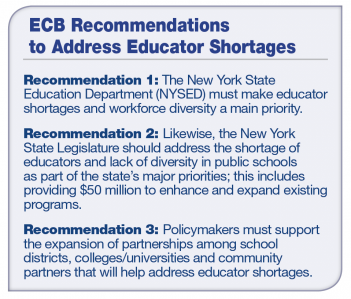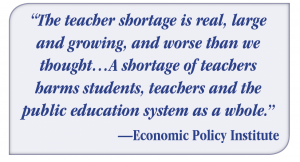Teacher Shortages Impede Educational Opportunities for Students
 Shortage of substitute teachers and lack of educator diversity add to the challenges
Shortage of substitute teachers and lack of educator diversity add to the challenges
The New York State Educational Conference Board (ECB)—which is made up of six leading educational organizations representing parents, classroom teachers, school-related professionals, building administrators, superintendents and school boards—is calling on policymakers to recognize the impact of educator shortages on students and to make it a priority to address those shortages. At the same time, state leaders must also make it a priority to increase diversity in our education workforce to better reflect the demographics of the students our schools serve and to support a more diverse workforce in every school. The forces behind these challenges differ, but many solutions overlap.
Background
Teacher shortages have been making headlines and raising concerns throughout the nation for the last several years and New York has not been immune. In fact, state officials estimate that districts will collectively need around 180,000 new teachers over the next decade. Given the downward trends in participation in teacher preparation programs, it is unlikely that demand
will be met. Between 2009 and 2017, enrollments in the state’s undergraduate and graduate teacher education programs declined 53%, from more than 79,000 students to approximately 37,000 students. Teacher retirements will continue to exacerbate the problem. According to November 2018 data from the New York State Teachers’ Retirement System (TRS), there were more than 51,000 active TRS members over 55 and nearly 36,000 between the ages of 50 and 54. This means around one-third of the 264,590 active TRS members are currently or will soon be eligible to retire. Consider these additional data points, which are representative of challenges throughout the state and the nation:
• In a recent survey by the New York State Council of School Superintendents (NYSCOSS), 71% of North Country superintendents said that finding an adequate number of teachers is a “significant problem” for their districts, as did 64%of respondents from the Southern Tier, 59% in high-poverty districts, 58% in cities and 54% in rural districts.
• Annually, up to 30% of new teachers leave the profession before their fifth year and the turnover rates are 50% higher in high-poverty districts compared with more affluent districts.
• The cost of hiring and/or replacing teachers is enormous. Urban districts alone spend more than $20,000 on average on each new hire; this includes hiring, training, recruitment and separation expenses. Nationally, the costs are estimated at more than $8 billion.

Trends in New York parallel the larger crisis
New York’s teacher shortages are reflective of larger trends throughout the United States. In the Learning Policy Institute’s 2016 report, “A Coming Crisis in Teaching? Teacher Supply, Demand and Shortages in the U.S.,” researchers projected the need for around 300,000 new teachers annually by 2020. In March 2019, the Economic Policy Institute reviewed the report, along with more recent data, and concluded, “The teacher shortage is real, large and growing, and worse than we thought…A shortage of teachers harms students, teachers and the public education system as a whole. Lack of sufficient, qualified teachers and staff instability threaten students’ ability to learn and reduce teachers’ effectiveness, and high teacher turnover consumes economic resources that could be better deployed elsewhere… In addition, the fact that the shortage is distributed so unevenly among students of different socioeconomic background challenges the U.S. education system’s goal of providing a sound education equitably to all children.”

Substitute teacher shortage also threatens education system
In addition to the overall teacher shortage, New York’s schools are also struggling to find substitute teachers. June 2019 survey data from the New York State School Boards Association (NYSSBA) indicates that 96% of superintendents had difficulties finding substitutes in the 2018-19 school year. District leaders also indicated that this was a long-standing problem for both daily and long-term substitutes. To further assess the problem, BOCES district superintendents conducted a month-long study to collect data on the number of teacher absences, requests for substitutes and the number of requests that could be filled. During this time, the rates at which substitutes could be secured varied widely throughout the state, from 59% to 94%; the average was 81%.
Several factors contribute to the shortage of substitutes. For example, individuals in teacher preparation programs (or recent graduates) often substitute so they can gain experience in the classroom; fewer enrollees mean, correspondingly, fewer substitutes. Also, when the economy is strong, those who might otherwise take substitute teaching positions opt for more secure full-time jobs with benefits. State regulations also hamper efforts to recruit substitute teachers, as individuals without certification cannot substitute for more than 40 days in a single school district each school year. New York’s classrooms also lacking educators from diverse backgrounds School districts are also grappling with the lack of diversity in the educator workforce—in short, the workforce is far from reflecting the rich diversity of students in New York or the nation as a whole. Currently, students of color and those from underrepresented groups comprise 56% of New York’s pupil enrollments, while 80% of teachers in the state are white. If current trends in teacher attrition rates continue, this gap will grow even more. According to the New York State Education Department (NYSED), between the 2017-18 and 2018-19 school years, 22% of black or African American teachers and 19% of Hispanic or Latino teachers did not return to the classroom; this compares to 13% of white teachers. In effect, fewer teachers of color are in the workforce and those who do enter are more likely than their white counterparts to leave the profession. The attrition rates result from a variety of factors. Teachers of color sometimes feel isolated due to an absence of colleagues from similar backgrounds. Additionally, they are more likely to be working in districts with high turnover rates, and they sometimes face unreasonable expectations—for example, they may be relied upon to bridge cultural divides and/or act as mentors to racially diverse students before considering their personal and professional growth.
Shortages are shortchanging our students
All of these shortages negatively impact our students:
• According to the Learning Policy Institute report mentioned earlier, teacher shortages may mean districts have to hire less experienced teachers, reduce the total number of courses offered or increase class sizes—all of which affect student learning. The report also points out, “turnover impacts
the achievement of all students in a school, not just those with a new teacher, by disrupting school stability, collegial relationships, collaboration, and the accumulation of institutional knowledge.” Taking this one step further, an examination of 850,000 New York City fourth- and fifth-graders over eight years showed math and English language arts achievement was lower for grades with high teacher turnover.
• Substitute teacher shortages also harm students. When substitutes are unavailable, regular faculty members sometimes give up their preparation periods to cover classes. This is a lose-lose situation for all students involved because teachers don’t have time to prepare for their classes or collaborate with colleagues. Building leaders and paraprofessionals might also step in to cover classes, meaning their regular job duties are compromised, as well.
• In some cases, students are “distributed” to other classrooms when substitute teachers cannot be placed into schools, leading to larger class sizes. Again, learning is disrupted, as educators aren’t always teaching at the same pace as their colleagues and students may be distributed to classes that are either ahead or behind their own class. The simple fact of being in a larger class also hampers pupil learning.
• The lack of diversity in the education workforce also negatively impacts New York’s learners. Research shows that teachers of color enhance the learning experiences of all students. In particular, these educators are more likely to see black or brown students’ potential and recommend them for advanced coursework, have higher expectations for their students of color and act as reliable role models and mentors. For white students, interacting with a diverse set of adults prepares them to successfully move through today’s continually changing workplaces and communities.
• Looking at the bigger picture, an overall shortage of teachers also affects the number of high-quality educational leaders for students, as principals are drawn from the teaching ranks.

Recommendations
While New York’s educational organizations and school districts are beginning to implement programs to address teacher shortages, additional supports are vital at the state level to expand and coordinate these efforts and ensure all districts and all children benefit. To this end, ECB puts forth the following recommendations:
Recommendation 1: The New York State Education Department (NYSED) must make educator shortages and workforce diversity a main priority.
Together, the shortage of regular and substitute teachers and the lack of a workforce that reflects the diversity of New York’s students and the broader society are impeding the educational opportunities for all pupils. NYSED must keep these issues front and center during all policy discussions. ECB members recommend that NYSED give special consideration to initiatives that will improve the status of the education profession, increase teacher retention and expand certification options.
Recommendation 2: The New York State Legislature should address the shortage of educators and lack of diversity in public schools as part of the state’s major priorities; this includes providing $50 million to enhance and expand to existing programs.
As stewards of New York’s youngest—and often most vulnerable populations—legislators must prioritize meeting the needs of public school children by supporting programs that will address the growing problem of teacher shortages, as well as the lack of educator diversity in K-12 schools. Additionally, ECB members call on policymakers to invest $50 million in the future of New York’s school children by supporting enhancements to existing initiatives that have a history of success (e.g., Teachers of Tomorrow programs, the Teacher Opportunity Corps and loan forgiveness programs). This funding could also help lessen some of the financial barriers to entering the teaching profession, including the costs for exams and certifications. A portion of the financial investment should also be targeted toward activities that attract and retain teachers, such as the mentoring and professional development initiatives and other innovative activities described earlier—activities that have proven successful, but need funding in order to be replicated and scaled up.
There is a long tradition in New York of funding improvements in facilities infrastructure in schools; it’s time to make the same investment in the infrastructure of the education workforce.
Recommendation 3: Policymakers must support the expansion of partnerships among school districts, colleges/universities and community partners that will help address educator shortages.
The collaborations among school districts, higher education and community-based organizations are showing positive results in small pockets of the state. This includes the residency, immersion and grow your own programs (described on page 3 in the feature on innovative initiatives), as well as activities like those taking place in Ithaca in which individuals working in community-based pre-K programs and/or daycare settings are offered opportunities to become certified and enter the teacher pipeline.
ECB urges New York’s policymakers to use these successes as a firm foundation to expand upon, and to explore how local organizations outside the education sector can also collaborate. This trifecta of collaboration between schools, higher education and community partners will be key to addressing the challenges of teacher shortages and lack of diversity.
Conclusion
In many ways, teacher shortages and the lack of diversity in education are becoming normalized—just another effect of past fiscal challenges in schools. This is not acceptable for New York’s students…or any school children in the nation. We must take decisive action now to ensure our children are the highest priority.
The New York State Educational Conference Board comprises the Conference of Big 5 School Districts; New York State Council of School Superintendents; New York State PTA; New York State School Boards Association; New York State United Teachers and the School Administrators Association of New York State. For more information, visit www.nysecb.org/ or follow ECB on Twitter at twitter.com/NYSECB.
